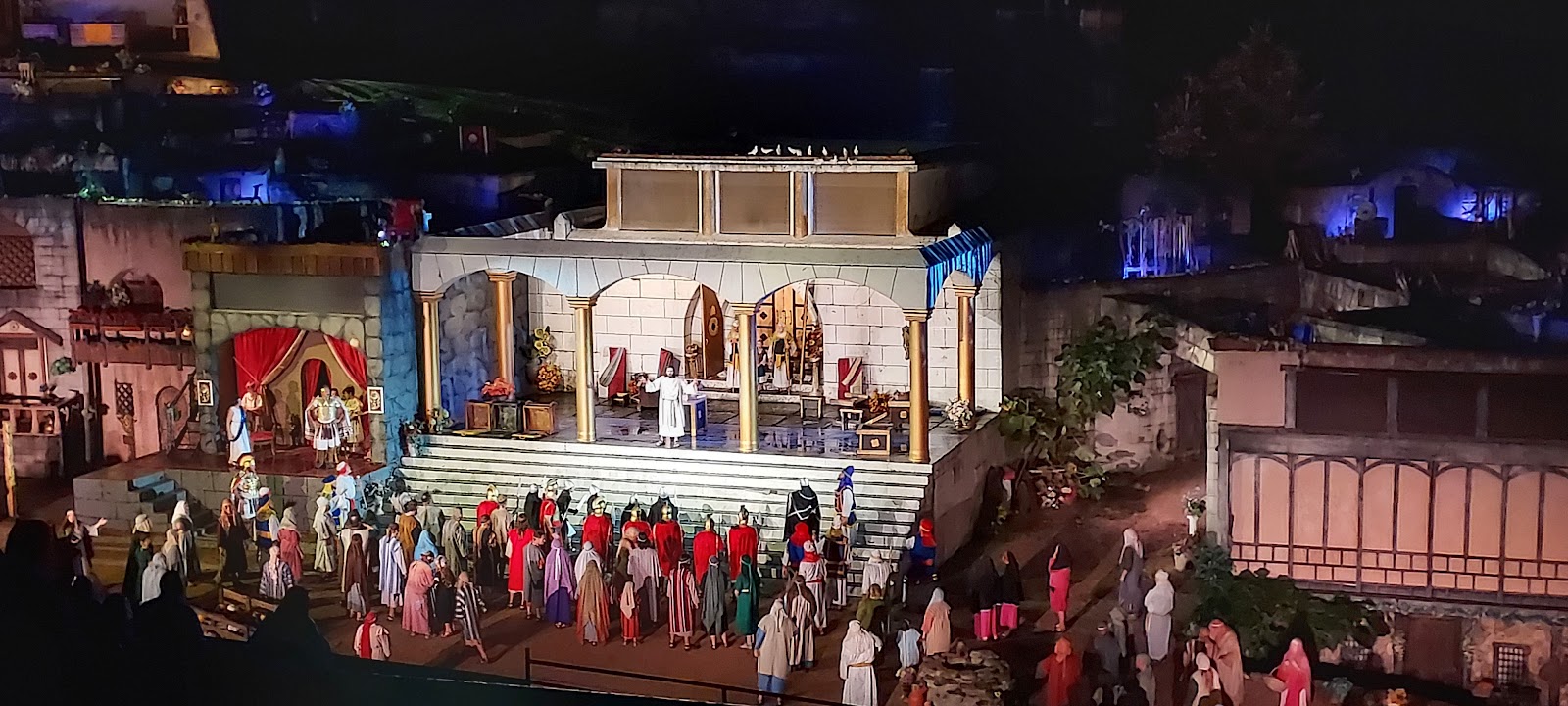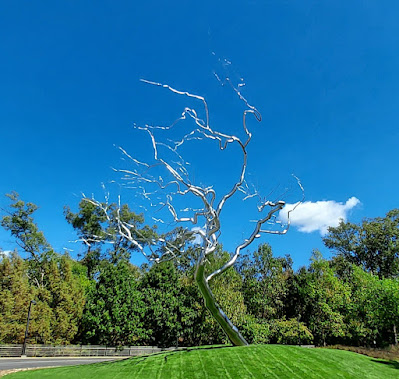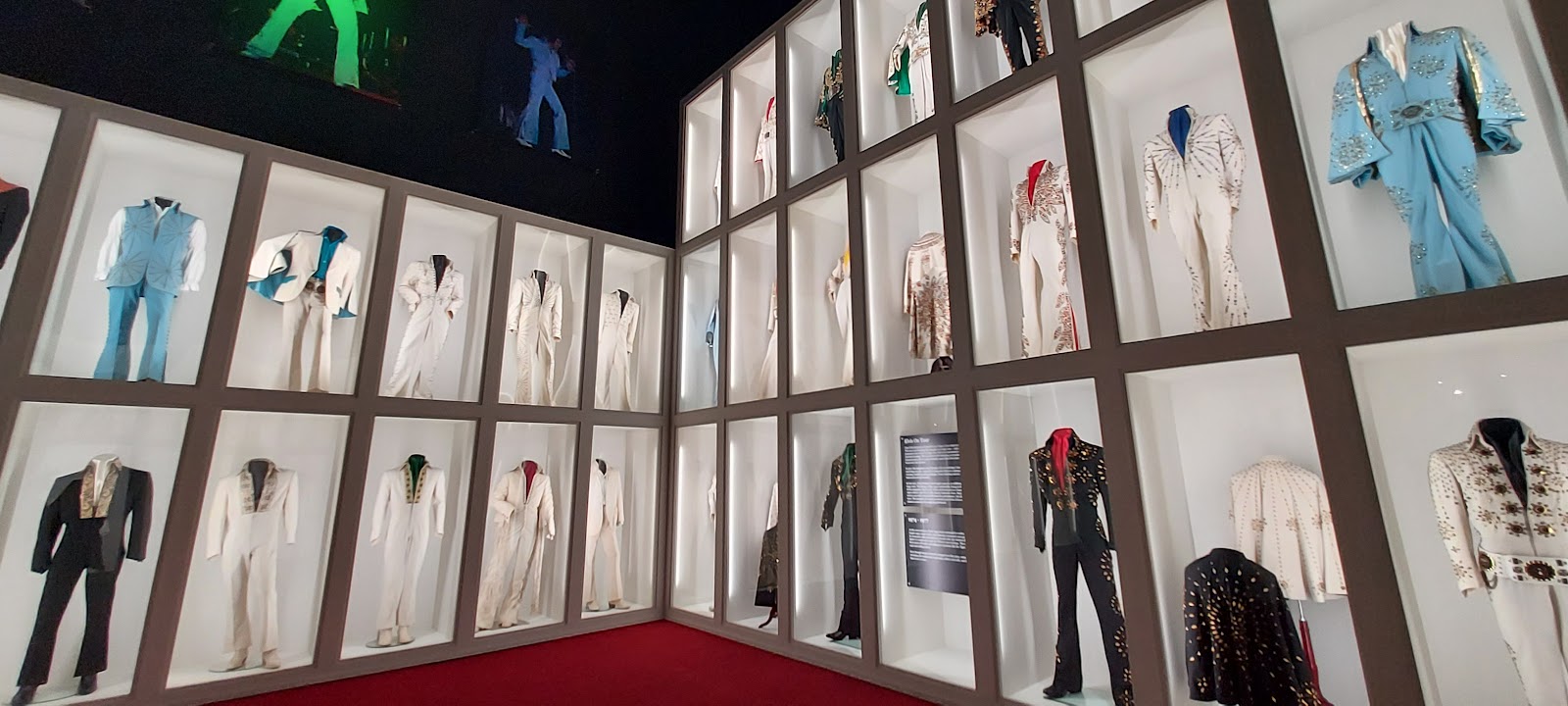Elvis sang in his hit movie, Double Trouble, “There is So Much World to See”, and I couldn’t agree more. So, we left Memphis, making our way to Eureka Springs, Arkansas.
Our first night was spent at St. Joseph Center, a wonderful
Harvest Hosts location in North Little Rock, Arkansas. Built in 1910, it was a Catholic orphanage
for 70 years, then a nursing home, school, and day care—all run by Benedictine
nuns. The Catholic Church put the Center
on the chopping block in 2008.
Thankfully, the community mobilized, created a nonprofit organization to
purchase the property, and transformed 50+ acres into a sustainable farm. The property is lovely. With farm animals (cows, goats, donkeys,
rabbits), vegetable and floral gardens, hiking trails, grottos and
statuary, St. Joseph Center is an ideal source of spiritual, emotional, and
physical nourishment. We were happy to
purchase freshly-picked veggies and high quality locally-sourced meats.
 |
| The Grotto of the Virgin Mary. |
 |
| A statue of St. Joseph, after whom the Center was named. |
 |
| Penny the herding dog keeps her goat friends on good behavior. |
Mom was anxious to get some steps in, so she and I hit the hiking trails and stopped to photograph the grotto. Now Mom may not be technologically- or mechanically-inclined, but the woman has an eagle eye. Upon returning to the rig, she noticed something hanging from the rear axle and called Dad outside to check it out. It turned out to be that a brake line had snapped at the fitting. Thankfully, Dad always carries his tools, spare brake lines, and extra vehicle fluids. So, he was able to make repairs on the spot.
 |
| Dad fixing the brake line. |
After another day of driving, we overnighted at Thor Elite Shooting Range, a Harvest Hosts location in Van Buren, Arkansas, which offers better accommodations than some RV parks. It has capacity for 2 RVs, including a site for an extra-large set-up like ours. We parked on a level concrete pad with access to a covered picnic area. Water and electricity are available for $35/night, but we did not partake, relying instead on our solar/battery system. However, Dad patronized the Hosts by purchasing a guest pass for $25 to gain access to the outdoor shooting range. The grounds have a nice pond, for which you can pay a fee to fish, but Mom and I just used its perimeter as a walking track while Dad did his target practice.
The next morning, we had an easy and relaxing drive along I-49 through the Boston Mountains. Then we got on US-62, which made for a slow ride because of its switchbacks and hairpin turns, but offered some nice views.
 |
| The leaves were just starting to don their fall colors. |
We arrived at our destination, Wanderlust RV Park in Eureka Springs, Arkansas. This is an awesome, well-maintained family-owned park. It has a welcoming and helpful staff, great mountain views, and a super clean laundry room. We were assigned an easy-to-access roadside site, so we did not need to unhitch Suite Retreat from Big Boomer. And it is just a few miles from The Great Passion Play, for which we purchased tickets. (We visited the grounds here back in 2020, but it was not a performance day for the Passion Play. We vowed to return, and we kept our promise).
 |
| A small sampling of the Autumn/Halloween decorations displayed throughout the Park. |
 |
| Some beautiful views... |
 |
| ...from the grounds of the RV Park. |
 |
| I found this to be the most unique paint job I have ever seen on an RV! The owner and fellow patron of Wanderlust RV Park gave me permission to take this photo. What a work of art! |
Though we experienced good weather during most of our time in Eureka Springs, that was not the case the evening when we attended the performance. It rained steadily throughout the entire 2-hour OUTDOOR re-enactment of Christ’s condemnation, crucifixion, and glorious resurrection. We were all quite wet, but that did not deter us (it was a minor inconvenience, especially when we reflect on what Jesus endured for all of us). The performance was superb, and we are so grateful we had the opportunity to witness it. Our ticket plan included a Holy Land tour prior to the performance, which provided insight to what life would be like during biblical times. We learned about ancient pottery-making, blacksmithing, and hunting techniques. We visited replicas of middle-Eastern vegetable gardens, buildings, and animal stables (like the one baby Jesus was born within). The Bible Museum on the premises is a must-see. Its collection holds 6,000+ copies of Bibles in hundreds of languages, including some very rare specimens like a 1535 Coverdale edition, which represents the first complete Modern English translation of the Bible. We also visited the Sacred Gallery, viewing modern and ancient works of art depicting Jesus. The grounds also include the beautiful Christ of the Ozarks statue. Reaching 7 stories tall, the statue consists of 34 tons of concrete and 24 layers of white mortar attached to a steel frame. No wonder it weighs more than 1,000 tons!
We arrived in Eureka Springs 2 weeks after their annual Jeep Jam and a few days after their Blues, BBQ, and Motorcycle Rally ended. Though both would have been fun events to attend, we were glad to have missed all the crowds. And since the leaves were just beginning to change color, the fall foliage fans had not arrived yet. So, we felt the timing of our visit was perfect, especially to facilitate a visit to Thorncrown Chapel, where the serenity of nature and the spiritual belief in a supreme being unite. Local resident Jim Reed commissioned architect E. Fay Jones, one-time apprentice to Frank Lloyd Wright, to fulfill Reed’s vision for a non-denominational meditation site for his 7-acre wooded parcel of land. What a masterpiece of art! Constructed of Southern Pine, the Chapel stands 4 stories tall and 60 feet wide, with “walls” of 425 glass windows. Jones certainly held true to Wright’s Prairie style, bringing the elements of nature indoors.
Speaking of Frank Lloyd Wright, we took a ride to nearby Bentonville, Arkansas, to visit Crystal Bridges Museum of American Art. The Museum is stunning! Designed by internationally-acclaimed architect, Moshe Safdie, it incorporates wood, glass, water, and soil. I know everyone talks about the rich elitists and the big bad corporations, but thanks to Alice Walton (of the Walmart dynasty) and other corporate benefactors, admission is FREE to the public for the general exhibition areas, beautiful grounds, and art in the park. However, if you wish to attend a special exhibit, a ticket is required.
So, you are probably wondering about my segue above and
saying to yourself, “what the heck does Frank Lloyd Wright have to do with
Crystal Bridges?” Well, on the grounds
of Crystal Bridges is the Bachman-Wilson House, designed by none other than
good old F. L. Wright. We have visited 6
Wright-designed buildings through the years (4 just this summer!), so we
were compelled to buy the special tickets for this house tour ($12/adult).
Wright was commissioned by Abraham Wilson in 1954 to build
the 1,700 square foot house in Millstone, New Jersey, at a cost of
$30,000. The home incorporates Wright’s
Usonian style designed for America’s middle-class residences: affordable, practical yet versatile, modern
yet simple. Wright built about 1,000
Usonian-styled homes, of which about 60 are still in existence, the
Bachman-Wilson home among them. But if
the house remained nestled along the banks of the Millstone River in New
Jersey, this would not be the case. You
see, the house flooded on at least 6 occasions. Thankfully, Lawrence and Sharon Tarantino,
the purchasers of the home in 1988 who restored it meticulously to its original
glory, wanted to preserve this piece of architectural history. Hence, the home was acquired by Crystal
Bridges. An Italian firm was hired to
laboriously disassemble the home, label each and every piece, relocate it to
the grounds of the Museum, and reassemble.
 |
| A model of the home. |
 |
| The front facade... |
 |
| ...of the home. |
 |
| The back of the house. |
Sadly, photography is not permitted indoors, but the docent
encouraged attendees to view pictures/video on the home’s website (https://crystalbridges.org/architecture/frank-lloyd-wright-bachman-wilson-house/)
The home features original living room furniture, original
lighting, radiant heating, and Philippine mahogany wood. A terrific tour, well worth the ticket price.
After the tour, we enjoyed lunch at the café, then burned
off some calories walking along the grounds and surrounding hiking/nature
trails. It was apparent that the area
suffered damage from a recent storm.
Sure enough, we learned a tornado went through the property in May
2024. More than 500 trees were
toppled, but, thankfully, the Museum building did not incur any damage.
 |
| Creative design made of recycled hand tools. |
 |
| Yours truly, Rambling RV Rat, becomes part of Art in the Park! |
Well, I am done rambling for now! But I’ll talk to you again soon!
























































































